Organisational Behaviour Report: Culture, Communication and Motivation
VerifiedAdded on 2020/12/09
|10
|2729
|278
Report
AI Summary
This report examines the role of organizational culture in enhancing organizational effectiveness, focusing on communication and employee motivation. The report begins by identifying the organizational culture of Tesco, a multinational retailer, using Handy's culture typology, including power, role, task, and person cultures. It then explores how effective communication strategies, such as Top-Down and Bottom-Up approaches, contribute to a positive organizational culture and improve operational efficiency. Furthermore, the report evaluates the impact of organizational culture on employee motivation, applying Maslow's Hierarchy of Needs to illustrate how companies can influence employee behavior and achieve their objectives. The report concludes with an assessment of how Tesco could leverage its organizational culture to further enhance its success, considering elements such as employee satisfaction and brand image.

Culture in an
organisation
organisation
Paraphrase This Document
Need a fresh take? Get an instant paraphrase of this document with our AI Paraphraser

EXECUTIVE SUMMARY
Culture plays a important role in every organisation and help in achieving the task
effectively. This reports emphasis on the importance of organisational culture. It includes Handy
culture model which discus about the employees culture. Communication provides direction to
company and provide guidance and motivates the employees to attain the organisational goal.
This is explained by Top-Down and Bottom-Up model. Moreover, motivation theory of
Maslow explains about the importance of motivation that helps in influencing the decision of
employees.
Culture plays a important role in every organisation and help in achieving the task
effectively. This reports emphasis on the importance of organisational culture. It includes Handy
culture model which discus about the employees culture. Communication provides direction to
company and provide guidance and motivates the employees to attain the organisational goal.
This is explained by Top-Down and Bottom-Up model. Moreover, motivation theory of
Maslow explains about the importance of motivation that helps in influencing the decision of
employees.
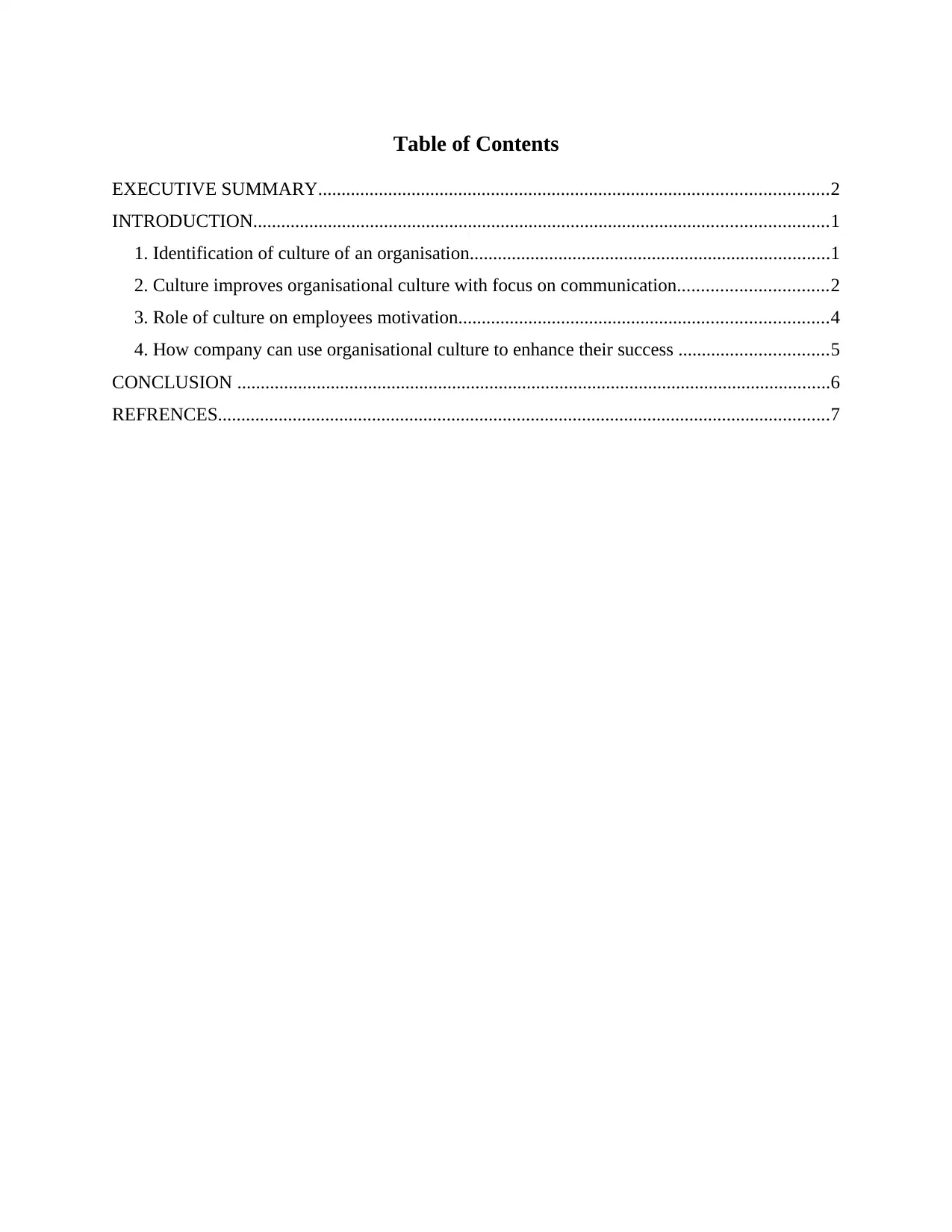
Table of Contents
EXECUTIVE SUMMARY.............................................................................................................2
INTRODUCTION...........................................................................................................................1
1. Identification of culture of an organisation.............................................................................1
2. Culture improves organisational culture with focus on communication................................2
3. Role of culture on employees motivation...............................................................................4
4. How company can use organisational culture to enhance their success ................................5
CONCLUSION ...............................................................................................................................6
REFRENCES...................................................................................................................................7
EXECUTIVE SUMMARY.............................................................................................................2
INTRODUCTION...........................................................................................................................1
1. Identification of culture of an organisation.............................................................................1
2. Culture improves organisational culture with focus on communication................................2
3. Role of culture on employees motivation...............................................................................4
4. How company can use organisational culture to enhance their success ................................5
CONCLUSION ...............................................................................................................................6
REFRENCES...................................................................................................................................7
⊘ This is a preview!⊘
Do you want full access?
Subscribe today to unlock all pages.

Trusted by 1+ million students worldwide
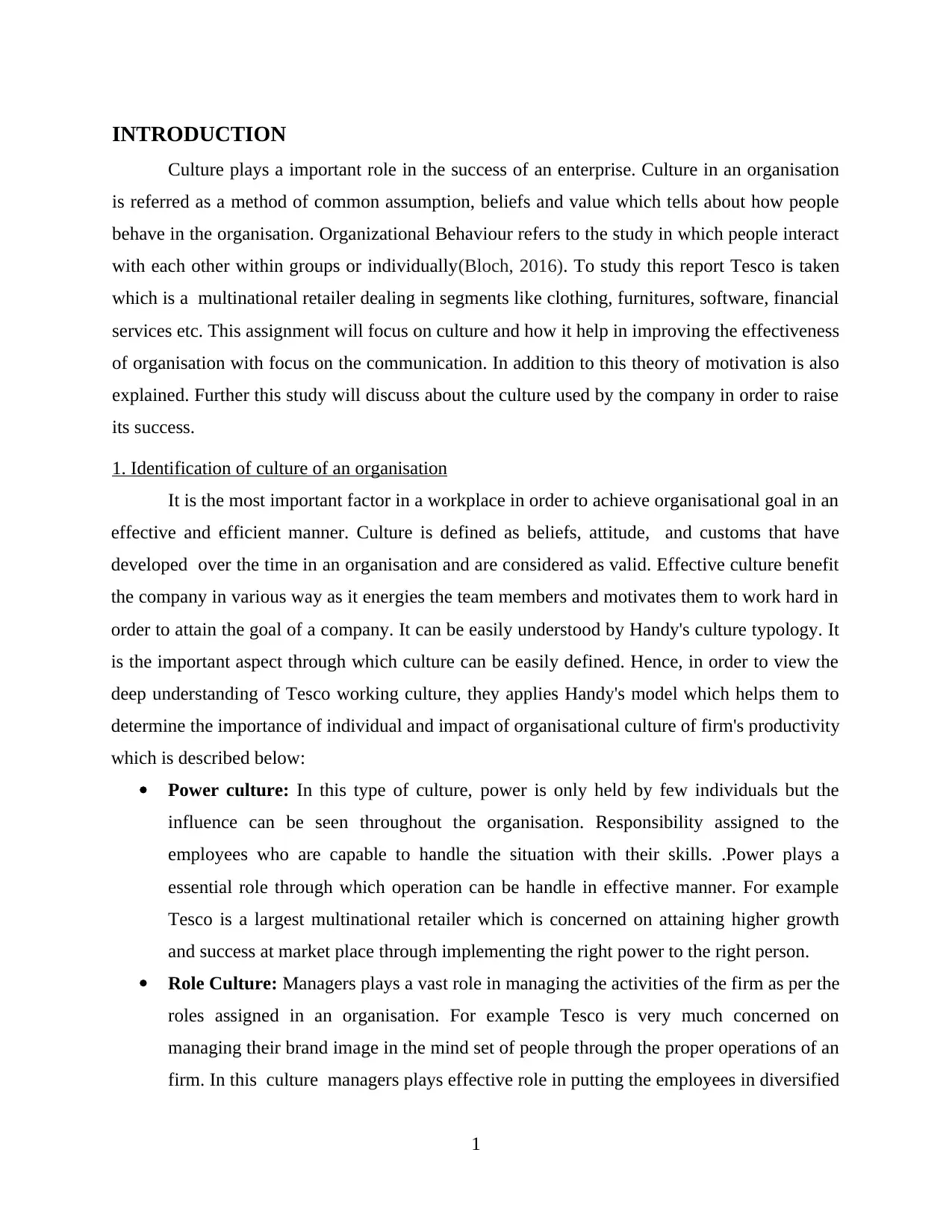
INTRODUCTION
Culture plays a important role in the success of an enterprise. Culture in an organisation
is referred as a method of common assumption, beliefs and value which tells about how people
behave in the organisation. Organizational Behaviour refers to the study in which people interact
with each other within groups or individually(Bloch, 2016). To study this report Tesco is taken
which is a multinational retailer dealing in segments like clothing, furnitures, software, financial
services etc. This assignment will focus on culture and how it help in improving the effectiveness
of organisation with focus on the communication. In addition to this theory of motivation is also
explained. Further this study will discuss about the culture used by the company in order to raise
its success.
1. Identification of culture of an organisation
It is the most important factor in a workplace in order to achieve organisational goal in an
effective and efficient manner. Culture is defined as beliefs, attitude, and customs that have
developed over the time in an organisation and are considered as valid. Effective culture benefit
the company in various way as it energies the team members and motivates them to work hard in
order to attain the goal of a company. It can be easily understood by Handy's culture typology. It
is the important aspect through which culture can be easily defined. Hence, in order to view the
deep understanding of Tesco working culture, they applies Handy's model which helps them to
determine the importance of individual and impact of organisational culture of firm's productivity
which is described below:
Power culture: In this type of culture, power is only held by few individuals but the
influence can be seen throughout the organisation. Responsibility assigned to the
employees who are capable to handle the situation with their skills. .Power plays a
essential role through which operation can be handle in effective manner. For example
Tesco is a largest multinational retailer which is concerned on attaining higher growth
and success at market place through implementing the right power to the right person.
Role Culture: Managers plays a vast role in managing the activities of the firm as per the
roles assigned in an organisation. For example Tesco is very much concerned on
managing their brand image in the mind set of people through the proper operations of an
firm. In this culture managers plays effective role in putting the employees in diversified
1
Culture plays a important role in the success of an enterprise. Culture in an organisation
is referred as a method of common assumption, beliefs and value which tells about how people
behave in the organisation. Organizational Behaviour refers to the study in which people interact
with each other within groups or individually(Bloch, 2016). To study this report Tesco is taken
which is a multinational retailer dealing in segments like clothing, furnitures, software, financial
services etc. This assignment will focus on culture and how it help in improving the effectiveness
of organisation with focus on the communication. In addition to this theory of motivation is also
explained. Further this study will discuss about the culture used by the company in order to raise
its success.
1. Identification of culture of an organisation
It is the most important factor in a workplace in order to achieve organisational goal in an
effective and efficient manner. Culture is defined as beliefs, attitude, and customs that have
developed over the time in an organisation and are considered as valid. Effective culture benefit
the company in various way as it energies the team members and motivates them to work hard in
order to attain the goal of a company. It can be easily understood by Handy's culture typology. It
is the important aspect through which culture can be easily defined. Hence, in order to view the
deep understanding of Tesco working culture, they applies Handy's model which helps them to
determine the importance of individual and impact of organisational culture of firm's productivity
which is described below:
Power culture: In this type of culture, power is only held by few individuals but the
influence can be seen throughout the organisation. Responsibility assigned to the
employees who are capable to handle the situation with their skills. .Power plays a
essential role through which operation can be handle in effective manner. For example
Tesco is a largest multinational retailer which is concerned on attaining higher growth
and success at market place through implementing the right power to the right person.
Role Culture: Managers plays a vast role in managing the activities of the firm as per the
roles assigned in an organisation. For example Tesco is very much concerned on
managing their brand image in the mind set of people through the proper operations of an
firm. In this culture managers plays effective role in putting the employees in diversified
1
Paraphrase This Document
Need a fresh take? Get an instant paraphrase of this document with our AI Paraphraser
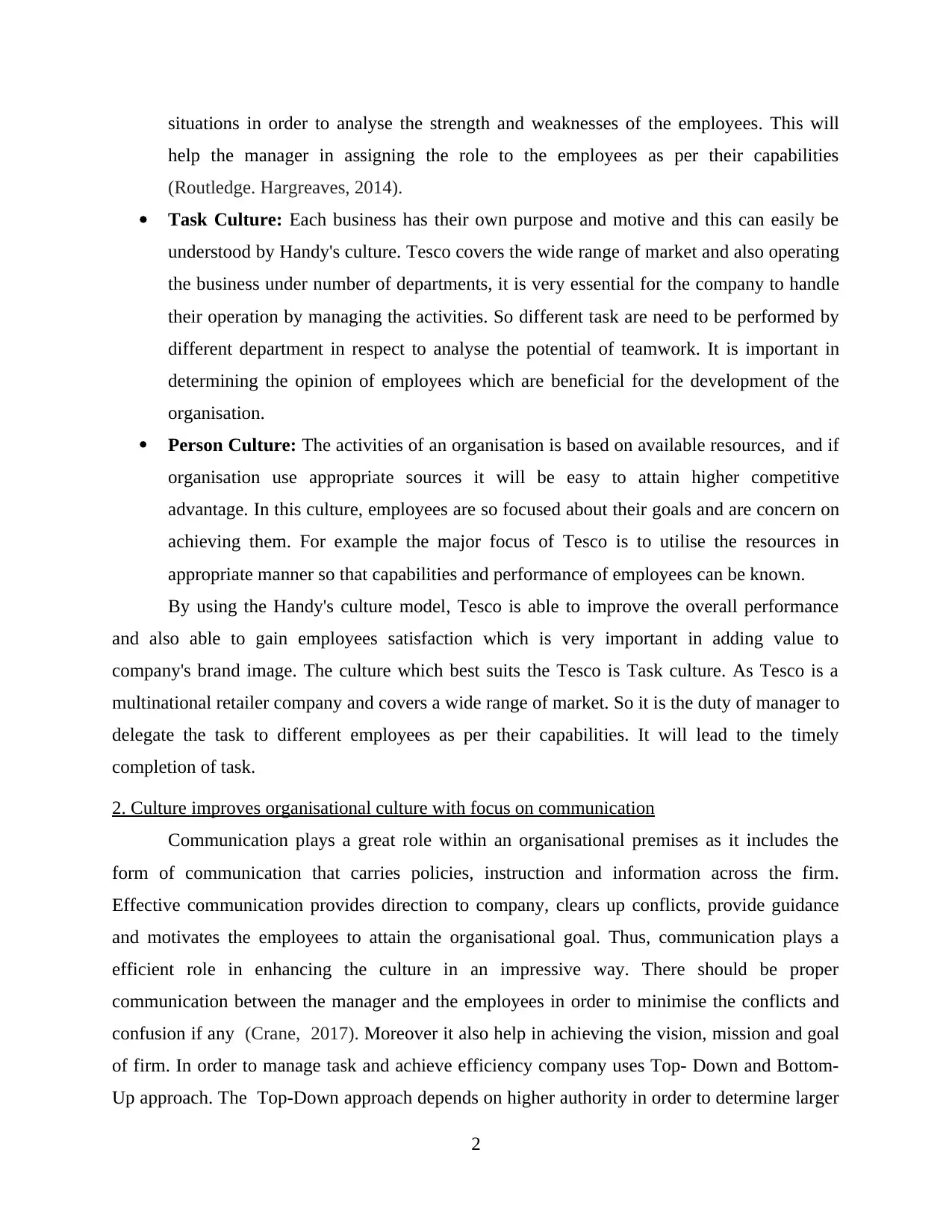
situations in order to analyse the strength and weaknesses of the employees. This will
help the manager in assigning the role to the employees as per their capabilities
(Routledge. Hargreaves, 2014).
Task Culture: Each business has their own purpose and motive and this can easily be
understood by Handy's culture. Tesco covers the wide range of market and also operating
the business under number of departments, it is very essential for the company to handle
their operation by managing the activities. So different task are need to be performed by
different department in respect to analyse the potential of teamwork. It is important in
determining the opinion of employees which are beneficial for the development of the
organisation.
Person Culture: The activities of an organisation is based on available resources, and if
organisation use appropriate sources it will be easy to attain higher competitive
advantage. In this culture, employees are so focused about their goals and are concern on
achieving them. For example the major focus of Tesco is to utilise the resources in
appropriate manner so that capabilities and performance of employees can be known.
By using the Handy's culture model, Tesco is able to improve the overall performance
and also able to gain employees satisfaction which is very important in adding value to
company's brand image. The culture which best suits the Tesco is Task culture. As Tesco is a
multinational retailer company and covers a wide range of market. So it is the duty of manager to
delegate the task to different employees as per their capabilities. It will lead to the timely
completion of task.
2. Culture improves organisational culture with focus on communication
Communication plays a great role within an organisational premises as it includes the
form of communication that carries policies, instruction and information across the firm.
Effective communication provides direction to company, clears up conflicts, provide guidance
and motivates the employees to attain the organisational goal. Thus, communication plays a
efficient role in enhancing the culture in an impressive way. There should be proper
communication between the manager and the employees in order to minimise the conflicts and
confusion if any (Crane, 2017). Moreover it also help in achieving the vision, mission and goal
of firm. In order to manage task and achieve efficiency company uses Top- Down and Bottom-
Up approach. The Top-Down approach depends on higher authority in order to determine larger
2
help the manager in assigning the role to the employees as per their capabilities
(Routledge. Hargreaves, 2014).
Task Culture: Each business has their own purpose and motive and this can easily be
understood by Handy's culture. Tesco covers the wide range of market and also operating
the business under number of departments, it is very essential for the company to handle
their operation by managing the activities. So different task are need to be performed by
different department in respect to analyse the potential of teamwork. It is important in
determining the opinion of employees which are beneficial for the development of the
organisation.
Person Culture: The activities of an organisation is based on available resources, and if
organisation use appropriate sources it will be easy to attain higher competitive
advantage. In this culture, employees are so focused about their goals and are concern on
achieving them. For example the major focus of Tesco is to utilise the resources in
appropriate manner so that capabilities and performance of employees can be known.
By using the Handy's culture model, Tesco is able to improve the overall performance
and also able to gain employees satisfaction which is very important in adding value to
company's brand image. The culture which best suits the Tesco is Task culture. As Tesco is a
multinational retailer company and covers a wide range of market. So it is the duty of manager to
delegate the task to different employees as per their capabilities. It will lead to the timely
completion of task.
2. Culture improves organisational culture with focus on communication
Communication plays a great role within an organisational premises as it includes the
form of communication that carries policies, instruction and information across the firm.
Effective communication provides direction to company, clears up conflicts, provide guidance
and motivates the employees to attain the organisational goal. Thus, communication plays a
efficient role in enhancing the culture in an impressive way. There should be proper
communication between the manager and the employees in order to minimise the conflicts and
confusion if any (Crane, 2017). Moreover it also help in achieving the vision, mission and goal
of firm. In order to manage task and achieve efficiency company uses Top- Down and Bottom-
Up approach. The Top-Down approach depends on higher authority in order to determine larger
2
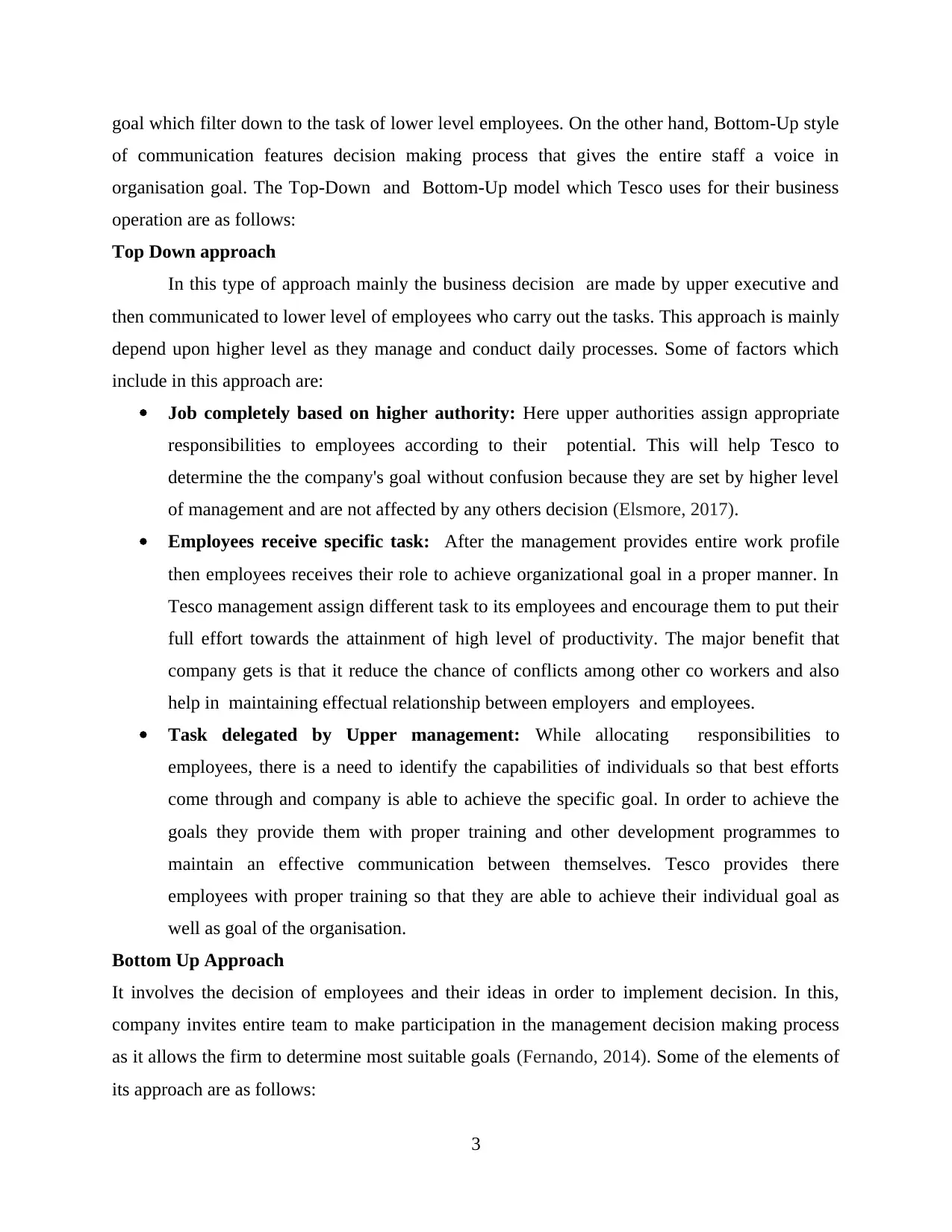
goal which filter down to the task of lower level employees. On the other hand, Bottom-Up style
of communication features decision making process that gives the entire staff a voice in
organisation goal. The Top-Down and Bottom-Up model which Tesco uses for their business
operation are as follows:
Top Down approach
In this type of approach mainly the business decision are made by upper executive and
then communicated to lower level of employees who carry out the tasks. This approach is mainly
depend upon higher level as they manage and conduct daily processes. Some of factors which
include in this approach are:
Job completely based on higher authority: Here upper authorities assign appropriate
responsibilities to employees according to their potential. This will help Tesco to
determine the the company's goal without confusion because they are set by higher level
of management and are not affected by any others decision (Elsmore, 2017).
Employees receive specific task: After the management provides entire work profile
then employees receives their role to achieve organizational goal in a proper manner. In
Tesco management assign different task to its employees and encourage them to put their
full effort towards the attainment of high level of productivity. The major benefit that
company gets is that it reduce the chance of conflicts among other co workers and also
help in maintaining effectual relationship between employers and employees.
Task delegated by Upper management: While allocating responsibilities to
employees, there is a need to identify the capabilities of individuals so that best efforts
come through and company is able to achieve the specific goal. In order to achieve the
goals they provide them with proper training and other development programmes to
maintain an effective communication between themselves. Tesco provides there
employees with proper training so that they are able to achieve their individual goal as
well as goal of the organisation.
Bottom Up Approach
It involves the decision of employees and their ideas in order to implement decision. In this,
company invites entire team to make participation in the management decision making process
as it allows the firm to determine most suitable goals (Fernando, 2014). Some of the elements of
its approach are as follows:
3
of communication features decision making process that gives the entire staff a voice in
organisation goal. The Top-Down and Bottom-Up model which Tesco uses for their business
operation are as follows:
Top Down approach
In this type of approach mainly the business decision are made by upper executive and
then communicated to lower level of employees who carry out the tasks. This approach is mainly
depend upon higher level as they manage and conduct daily processes. Some of factors which
include in this approach are:
Job completely based on higher authority: Here upper authorities assign appropriate
responsibilities to employees according to their potential. This will help Tesco to
determine the the company's goal without confusion because they are set by higher level
of management and are not affected by any others decision (Elsmore, 2017).
Employees receive specific task: After the management provides entire work profile
then employees receives their role to achieve organizational goal in a proper manner. In
Tesco management assign different task to its employees and encourage them to put their
full effort towards the attainment of high level of productivity. The major benefit that
company gets is that it reduce the chance of conflicts among other co workers and also
help in maintaining effectual relationship between employers and employees.
Task delegated by Upper management: While allocating responsibilities to
employees, there is a need to identify the capabilities of individuals so that best efforts
come through and company is able to achieve the specific goal. In order to achieve the
goals they provide them with proper training and other development programmes to
maintain an effective communication between themselves. Tesco provides there
employees with proper training so that they are able to achieve their individual goal as
well as goal of the organisation.
Bottom Up Approach
It involves the decision of employees and their ideas in order to implement decision. In this,
company invites entire team to make participation in the management decision making process
as it allows the firm to determine most suitable goals (Fernando, 2014). Some of the elements of
its approach are as follows:
3
⊘ This is a preview!⊘
Do you want full access?
Subscribe today to unlock all pages.

Trusted by 1+ million students worldwide
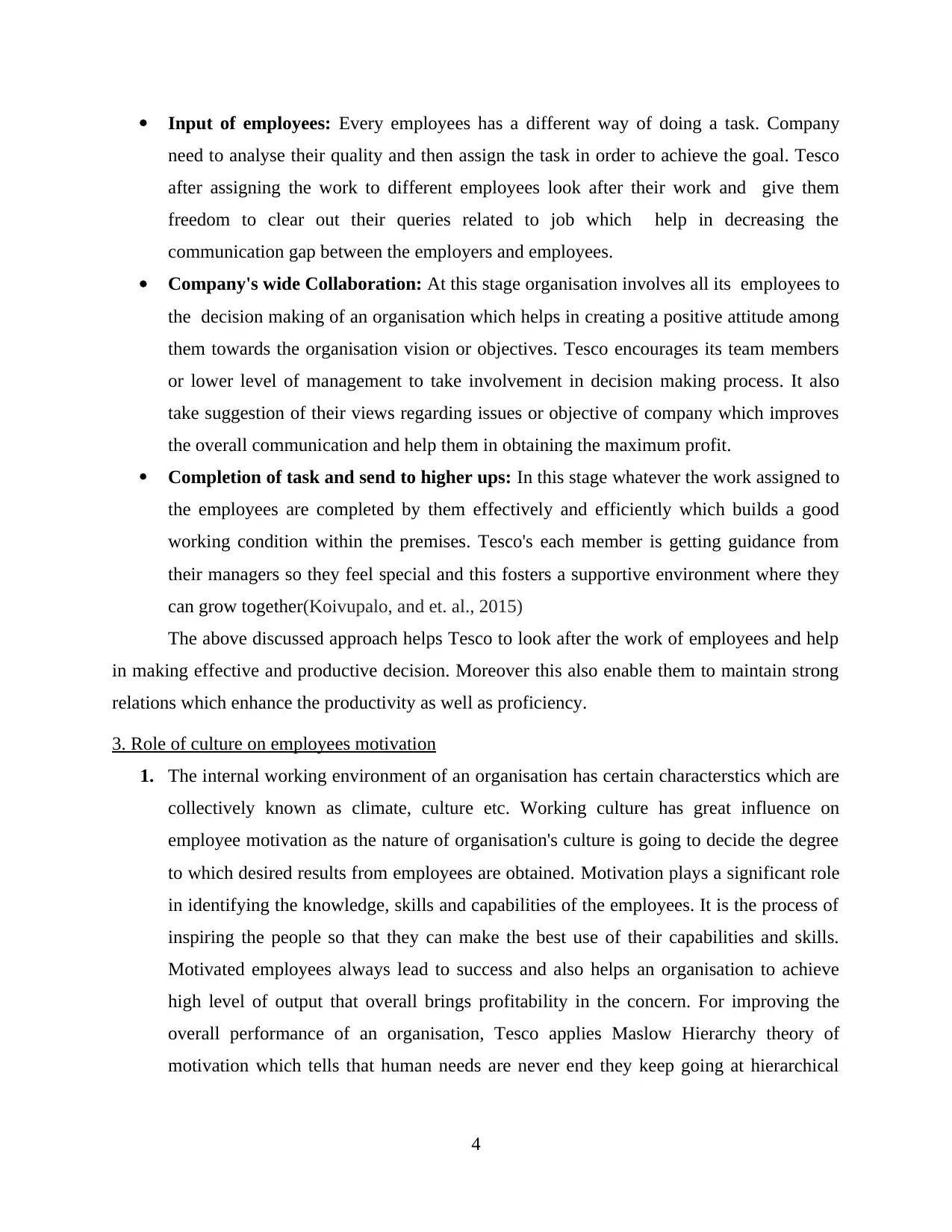
Input of employees: Every employees has a different way of doing a task. Company
need to analyse their quality and then assign the task in order to achieve the goal. Tesco
after assigning the work to different employees look after their work and give them
freedom to clear out their queries related to job which help in decreasing the
communication gap between the employers and employees.
Company's wide Collaboration: At this stage organisation involves all its employees to
the decision making of an organisation which helps in creating a positive attitude among
them towards the organisation vision or objectives. Tesco encourages its team members
or lower level of management to take involvement in decision making process. It also
take suggestion of their views regarding issues or objective of company which improves
the overall communication and help them in obtaining the maximum profit.
Completion of task and send to higher ups: In this stage whatever the work assigned to
the employees are completed by them effectively and efficiently which builds a good
working condition within the premises. Tesco's each member is getting guidance from
their managers so they feel special and this fosters a supportive environment where they
can grow together(Koivupalo, and et. al., 2015)
The above discussed approach helps Tesco to look after the work of employees and help
in making effective and productive decision. Moreover this also enable them to maintain strong
relations which enhance the productivity as well as proficiency.
3. Role of culture on employees motivation
1. The internal working environment of an organisation has certain characterstics which are
collectively known as climate, culture etc. Working culture has great influence on
employee motivation as the nature of organisation's culture is going to decide the degree
to which desired results from employees are obtained. Motivation plays a significant role
in identifying the knowledge, skills and capabilities of the employees. It is the process of
inspiring the people so that they can make the best use of their capabilities and skills.
Motivated employees always lead to success and also helps an organisation to achieve
high level of output that overall brings profitability in the concern. For improving the
overall performance of an organisation, Tesco applies Maslow Hierarchy theory of
motivation which tells that human needs are never end they keep going at hierarchical
4
need to analyse their quality and then assign the task in order to achieve the goal. Tesco
after assigning the work to different employees look after their work and give them
freedom to clear out their queries related to job which help in decreasing the
communication gap between the employers and employees.
Company's wide Collaboration: At this stage organisation involves all its employees to
the decision making of an organisation which helps in creating a positive attitude among
them towards the organisation vision or objectives. Tesco encourages its team members
or lower level of management to take involvement in decision making process. It also
take suggestion of their views regarding issues or objective of company which improves
the overall communication and help them in obtaining the maximum profit.
Completion of task and send to higher ups: In this stage whatever the work assigned to
the employees are completed by them effectively and efficiently which builds a good
working condition within the premises. Tesco's each member is getting guidance from
their managers so they feel special and this fosters a supportive environment where they
can grow together(Koivupalo, and et. al., 2015)
The above discussed approach helps Tesco to look after the work of employees and help
in making effective and productive decision. Moreover this also enable them to maintain strong
relations which enhance the productivity as well as proficiency.
3. Role of culture on employees motivation
1. The internal working environment of an organisation has certain characterstics which are
collectively known as climate, culture etc. Working culture has great influence on
employee motivation as the nature of organisation's culture is going to decide the degree
to which desired results from employees are obtained. Motivation plays a significant role
in identifying the knowledge, skills and capabilities of the employees. It is the process of
inspiring the people so that they can make the best use of their capabilities and skills.
Motivated employees always lead to success and also helps an organisation to achieve
high level of output that overall brings profitability in the concern. For improving the
overall performance of an organisation, Tesco applies Maslow Hierarchy theory of
motivation which tells that human needs are never end they keep going at hierarchical
4
Paraphrase This Document
Need a fresh take? Get an instant paraphrase of this document with our AI Paraphraser
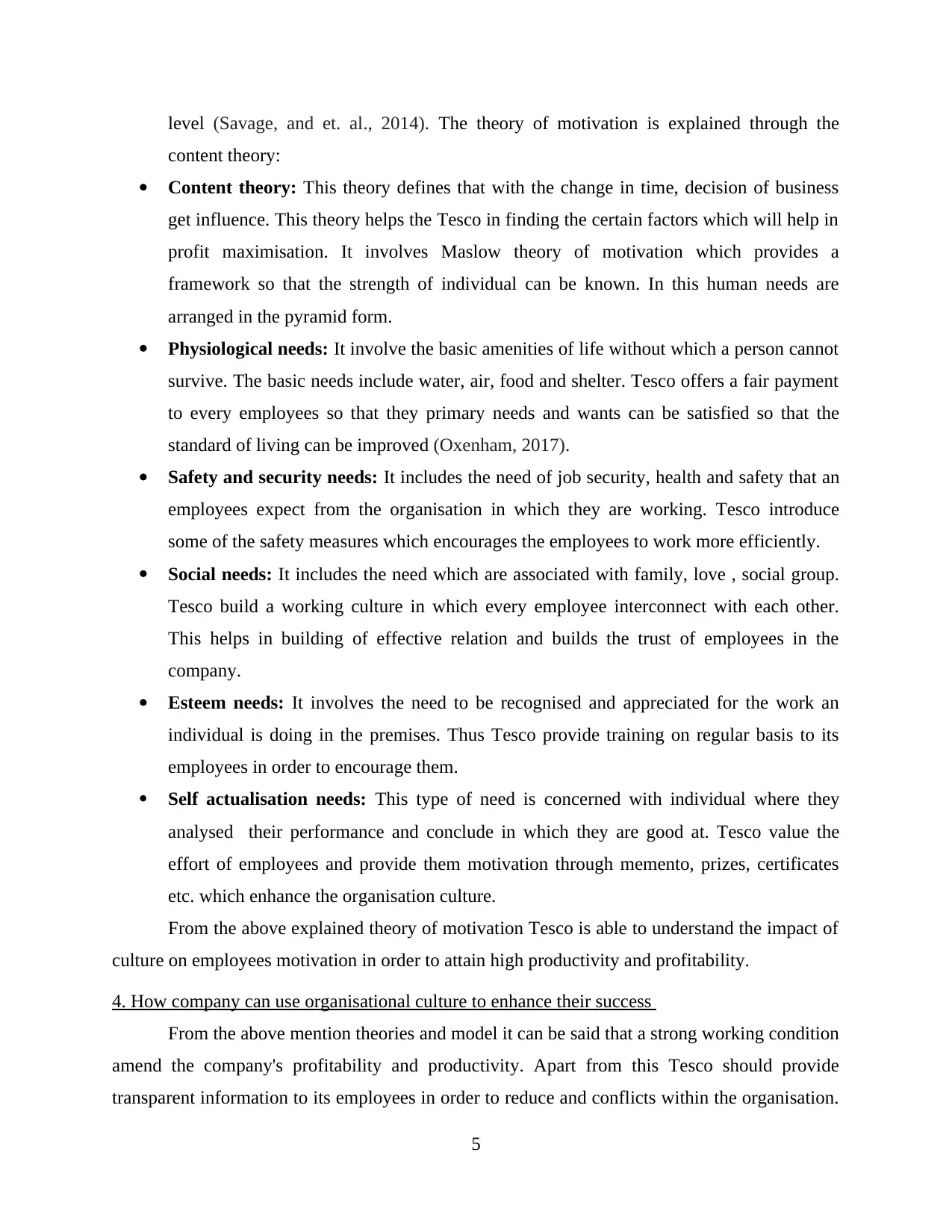
level (Savage, and et. al., 2014). The theory of motivation is explained through the
content theory:
Content theory: This theory defines that with the change in time, decision of business
get influence. This theory helps the Tesco in finding the certain factors which will help in
profit maximisation. It involves Maslow theory of motivation which provides a
framework so that the strength of individual can be known. In this human needs are
arranged in the pyramid form.
Physiological needs: It involve the basic amenities of life without which a person cannot
survive. The basic needs include water, air, food and shelter. Tesco offers a fair payment
to every employees so that they primary needs and wants can be satisfied so that the
standard of living can be improved (Oxenham, 2017).
Safety and security needs: It includes the need of job security, health and safety that an
employees expect from the organisation in which they are working. Tesco introduce
some of the safety measures which encourages the employees to work more efficiently.
Social needs: It includes the need which are associated with family, love , social group.
Tesco build a working culture in which every employee interconnect with each other.
This helps in building of effective relation and builds the trust of employees in the
company.
Esteem needs: It involves the need to be recognised and appreciated for the work an
individual is doing in the premises. Thus Tesco provide training on regular basis to its
employees in order to encourage them.
Self actualisation needs: This type of need is concerned with individual where they
analysed their performance and conclude in which they are good at. Tesco value the
effort of employees and provide them motivation through memento, prizes, certificates
etc. which enhance the organisation culture.
From the above explained theory of motivation Tesco is able to understand the impact of
culture on employees motivation in order to attain high productivity and profitability.
4. How company can use organisational culture to enhance their success
From the above mention theories and model it can be said that a strong working condition
amend the company's profitability and productivity. Apart from this Tesco should provide
transparent information to its employees in order to reduce and conflicts within the organisation.
5
content theory:
Content theory: This theory defines that with the change in time, decision of business
get influence. This theory helps the Tesco in finding the certain factors which will help in
profit maximisation. It involves Maslow theory of motivation which provides a
framework so that the strength of individual can be known. In this human needs are
arranged in the pyramid form.
Physiological needs: It involve the basic amenities of life without which a person cannot
survive. The basic needs include water, air, food and shelter. Tesco offers a fair payment
to every employees so that they primary needs and wants can be satisfied so that the
standard of living can be improved (Oxenham, 2017).
Safety and security needs: It includes the need of job security, health and safety that an
employees expect from the organisation in which they are working. Tesco introduce
some of the safety measures which encourages the employees to work more efficiently.
Social needs: It includes the need which are associated with family, love , social group.
Tesco build a working culture in which every employee interconnect with each other.
This helps in building of effective relation and builds the trust of employees in the
company.
Esteem needs: It involves the need to be recognised and appreciated for the work an
individual is doing in the premises. Thus Tesco provide training on regular basis to its
employees in order to encourage them.
Self actualisation needs: This type of need is concerned with individual where they
analysed their performance and conclude in which they are good at. Tesco value the
effort of employees and provide them motivation through memento, prizes, certificates
etc. which enhance the organisation culture.
From the above explained theory of motivation Tesco is able to understand the impact of
culture on employees motivation in order to attain high productivity and profitability.
4. How company can use organisational culture to enhance their success
From the above mention theories and model it can be said that a strong working condition
amend the company's profitability and productivity. Apart from this Tesco should provide
transparent information to its employees in order to reduce and conflicts within the organisation.
5

Tesco should treat every employees equally. They should respect the value of each individual by
providing fair reward to them (Pedler and Burgoyne, 2017). This will help the employees to get
highest satisfaction and will help Tesco to gain competitive advantage from its competitors in
terms of culture of organisation.
CONCLUSION
The above mentioned report conclude that an effective organisational culture plays a important
role in accomplishment of goals of the business. Through a proper communication a relationship
can be maintained between the employees. Effective communication also reduces the conflicts or
disputes within the organisation. Moreover, Handy's model enables the fair working culture
which impact the employees motivation and improves the overall performance of the company.
The Up Down approach helps an organisation to identify the capabilities of the individual and
provide them proper direction to work. Apart from this, company also invite other employees to
took participation in business decision making process which improves their morale and
confidence. Moreover, Maslow hierarchy theory allow the firm to provide fair reward so that the
basic needs can be fulfilled. Thus its concluded that if the organisational culture is healthy it will
help in achieving of the task on time without any obstacles.
6
providing fair reward to them (Pedler and Burgoyne, 2017). This will help the employees to get
highest satisfaction and will help Tesco to gain competitive advantage from its competitors in
terms of culture of organisation.
CONCLUSION
The above mentioned report conclude that an effective organisational culture plays a important
role in accomplishment of goals of the business. Through a proper communication a relationship
can be maintained between the employees. Effective communication also reduces the conflicts or
disputes within the organisation. Moreover, Handy's model enables the fair working culture
which impact the employees motivation and improves the overall performance of the company.
The Up Down approach helps an organisation to identify the capabilities of the individual and
provide them proper direction to work. Apart from this, company also invite other employees to
took participation in business decision making process which improves their morale and
confidence. Moreover, Maslow hierarchy theory allow the firm to provide fair reward so that the
basic needs can be fulfilled. Thus its concluded that if the organisational culture is healthy it will
help in achieving of the task on time without any obstacles.
6
⊘ This is a preview!⊘
Do you want full access?
Subscribe today to unlock all pages.

Trusted by 1+ million students worldwide
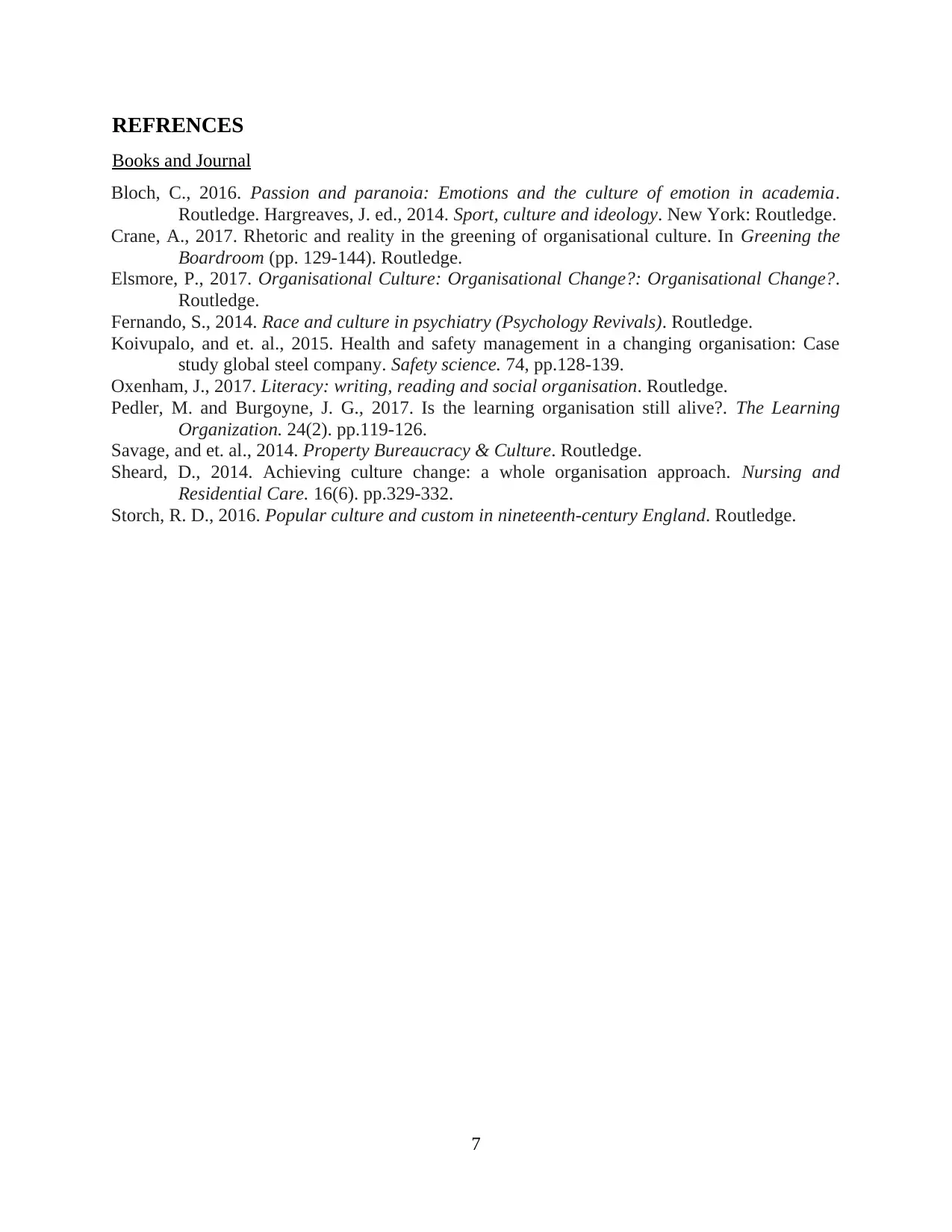
REFRENCES
Books and Journal
Bloch, C., 2016. Passion and paranoia: Emotions and the culture of emotion in academia.
Routledge. Hargreaves, J. ed., 2014. Sport, culture and ideology. New York: Routledge.
Crane, A., 2017. Rhetoric and reality in the greening of organisational culture. In Greening the
Boardroom (pp. 129-144). Routledge.
Elsmore, P., 2017. Organisational Culture: Organisational Change?: Organisational Change?.
Routledge.
Fernando, S., 2014. Race and culture in psychiatry (Psychology Revivals). Routledge.
Koivupalo, and et. al., 2015. Health and safety management in a changing organisation: Case
study global steel company. Safety science. 74, pp.128-139.
Oxenham, J., 2017. Literacy: writing, reading and social organisation. Routledge.
Pedler, M. and Burgoyne, J. G., 2017. Is the learning organisation still alive?. The Learning
Organization. 24(2). pp.119-126.
Savage, and et. al., 2014. Property Bureaucracy & Culture. Routledge.
Sheard, D., 2014. Achieving culture change: a whole organisation approach. Nursing and
Residential Care. 16(6). pp.329-332.
Storch, R. D., 2016. Popular culture and custom in nineteenth-century England. Routledge.
7
Books and Journal
Bloch, C., 2016. Passion and paranoia: Emotions and the culture of emotion in academia.
Routledge. Hargreaves, J. ed., 2014. Sport, culture and ideology. New York: Routledge.
Crane, A., 2017. Rhetoric and reality in the greening of organisational culture. In Greening the
Boardroom (pp. 129-144). Routledge.
Elsmore, P., 2017. Organisational Culture: Organisational Change?: Organisational Change?.
Routledge.
Fernando, S., 2014. Race and culture in psychiatry (Psychology Revivals). Routledge.
Koivupalo, and et. al., 2015. Health and safety management in a changing organisation: Case
study global steel company. Safety science. 74, pp.128-139.
Oxenham, J., 2017. Literacy: writing, reading and social organisation. Routledge.
Pedler, M. and Burgoyne, J. G., 2017. Is the learning organisation still alive?. The Learning
Organization. 24(2). pp.119-126.
Savage, and et. al., 2014. Property Bureaucracy & Culture. Routledge.
Sheard, D., 2014. Achieving culture change: a whole organisation approach. Nursing and
Residential Care. 16(6). pp.329-332.
Storch, R. D., 2016. Popular culture and custom in nineteenth-century England. Routledge.
7
1 out of 10
Related Documents
Your All-in-One AI-Powered Toolkit for Academic Success.
+13062052269
info@desklib.com
Available 24*7 on WhatsApp / Email
![[object Object]](/_next/static/media/star-bottom.7253800d.svg)
Unlock your academic potential
Copyright © 2020–2025 A2Z Services. All Rights Reserved. Developed and managed by ZUCOL.





